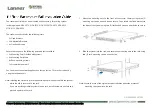
Technical basics
|
|
ELSA LANCOM Business 6000
|
114
EN
network protocols are IPX or Apple Talk. Because of its wide use, this chapter
deals mainly with the TCP/IP.
IP network
All hosts wanting to communicate using the TCP/IP protocol have to be
plugged into the same network and have to have the TCP/IP protocol (also
known as TCP/IP stack) installed. Such a network is referred to as an IP
network.
Internetwork
Internet
The connection of multiple networks based on the IP protocol is referred to
as an internetwork. The largest union of many small, public IP networks is the
Internet.
Local Area Network
(LAN)
A network covering a limited area with hosts on the same hierarchical level
and using the same medium (shared medium) is called a local network (
L
ocal
A
rea
N
etwork, LAN).
7.2
IP addressing
Packet-oriented
transfer
In IP networks the communication between computers takes place in a packet
oriented fashion. This means that data or messages are packed together in
parcels of variable length and are as such sent from the source computer to
the target computer. Apart from the actual information to be transmitted
(useful data), the data packet also contains address and control information.
IP address
IP addresses are used in IP networks for communications between various
devices. In this case, every host has its own unique address by which it can
be identified unambiguously. What does an IP address look like? It consists
of four bytes separated by points, making a total of 32 bits. Each of the four
bytes can take on values from 0 to 255, e.g. 192.168.130.124.
To be precise, the IP address refers to the interface, and not the host itself. A
terminal device with more than one interface (such as a router) has to have
an IP address at its disposal for every single interface. This is why ISDN
routers from ELSA for example, have an IP address for communication with
the hosts in their own network, as well as a second IP address for
communication with the “outside world” using the ISDN network. In the
same way, ELSA cable modems have an IP address for their own network and
another IP address for the exchange of data with the cable network.
Network address
An IP address contains the address of the network as well as that of the host.
The network address is the same for all hosts on one network, whereas the
address of the host is exclusive and unique to the network. A router, for
example, can have more than one IP address, each one unique to the network.
Summary of Contents for LANCOM Business 6000
Page 1: ...ELSA LANCOM TM Business 6000...
Page 4: ...ELSA LANCOM Business 6000 EN...
Page 10: ...Introduction ELSA LANCOM Business 6000 10 EN...
Page 52: ...Connection via 2 Mbit interface ELSA LANCOM Business 6000 52 EN...
Page 110: ...Operating modes and functions ELSA LANCOM Business 6000 110 EN...
Page 162: ...Technical data ELSA LANCOM Business 6000 162 EN...
















































